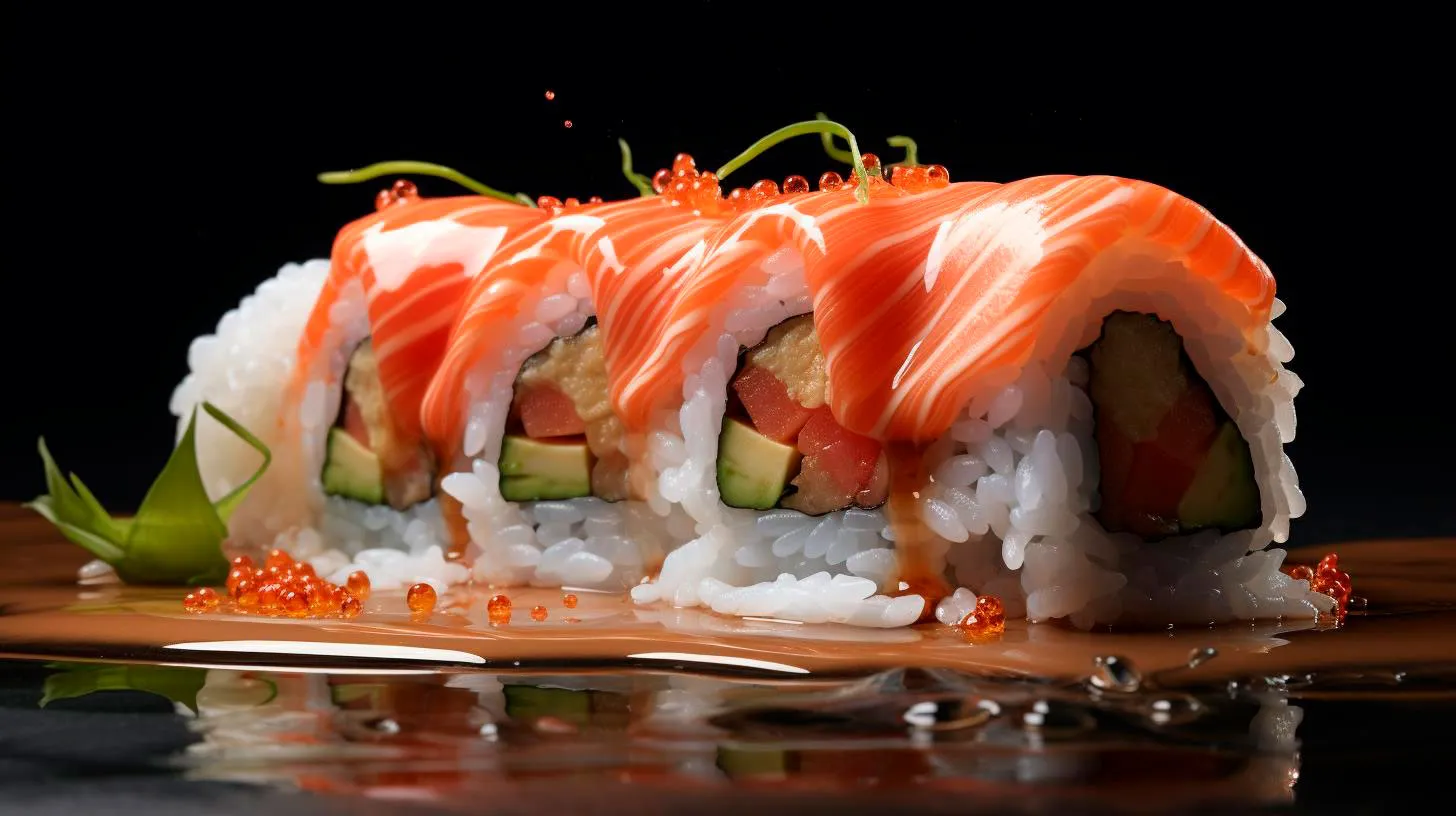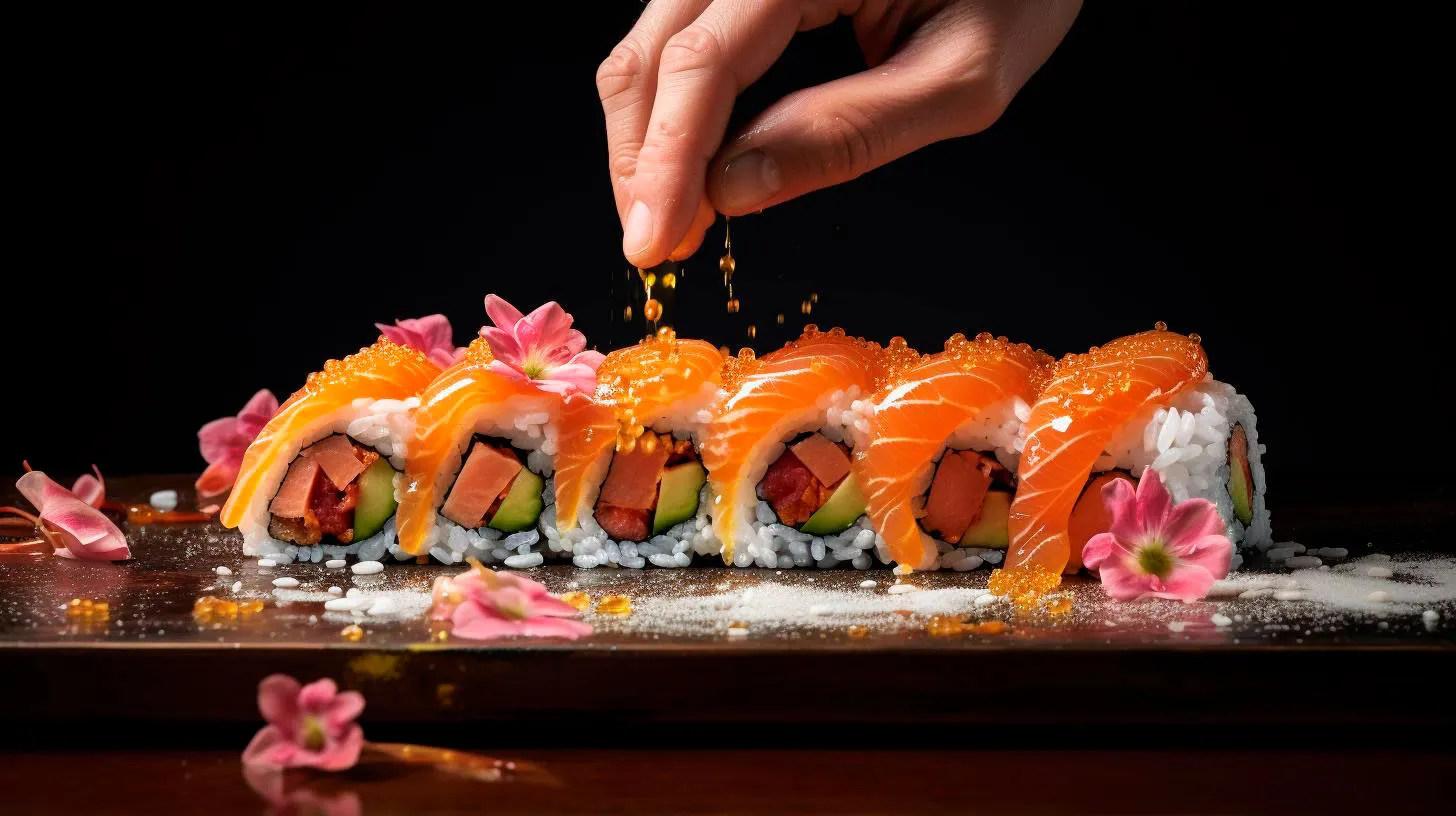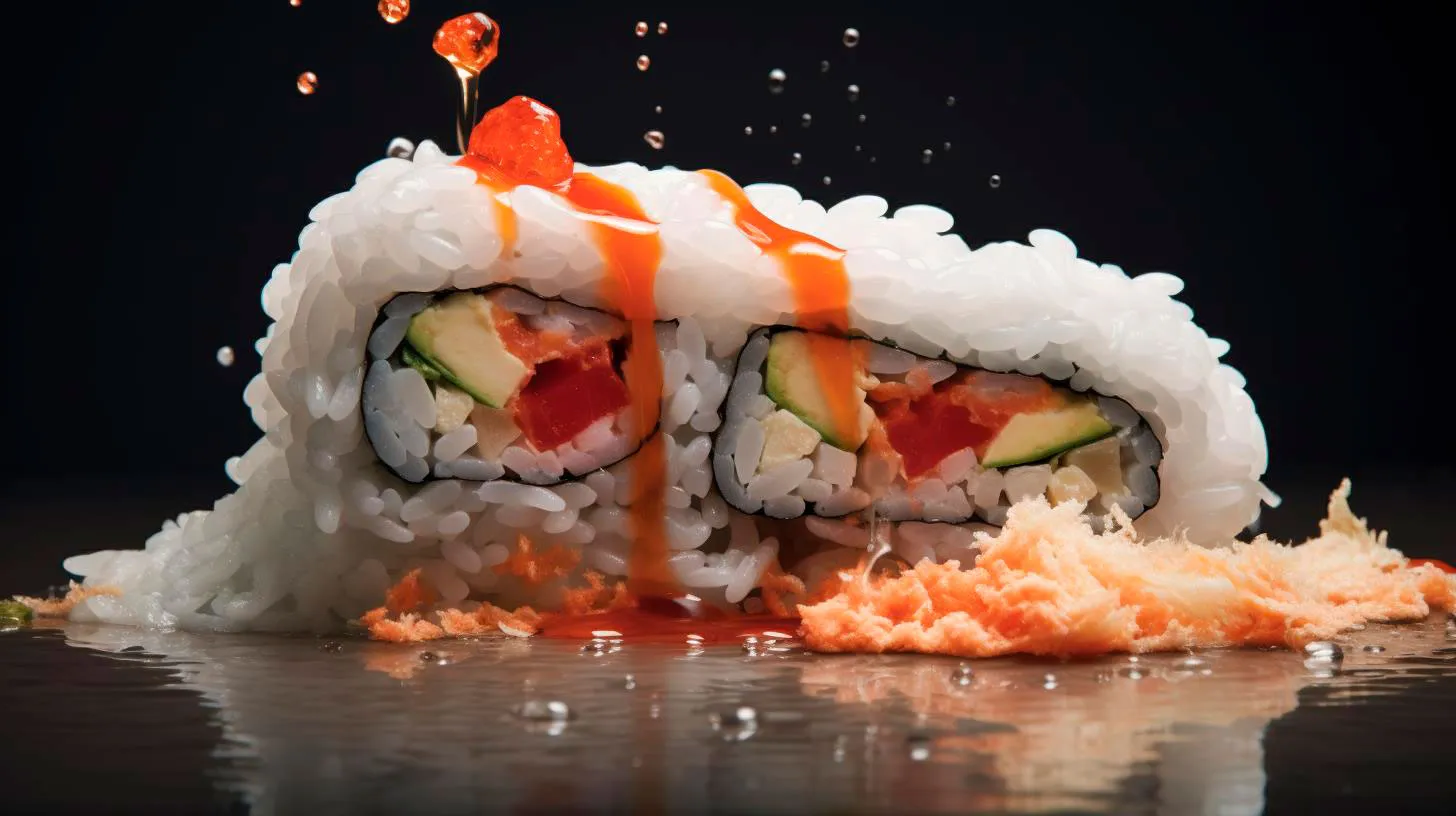Master the Art of Sushi with Inspiration from Food Documentaries
One such source of inspiration is food documentaries. In this article, we’ll explore how food documentaries can help you master the art of sushi, providing you with the knowledge, techniques, and motivation you need to create delicious sushi rolls in your own kitchen.
1. Sushi: The Iconic Japanese Cuisine
If you’re new to sushi, it’s essential to have a solid understanding of its history, techniques, and cultural significance. One documentary that beautifully delves into the world of sushi is “Jiro Dreams of Sushi”. This acclaimed film follows the story of Jiro Ono, an 85-year-old sushi master, and his quest for perfection in his small Tokyo restaurant. Through the documentary, viewers gain insights into the passion, dedication, and philosophy that surrounds sushi-making.
Key Takeaways:
- Understand the importance of technique and attention to detail in sushi-making.
- Appreciate the cultural significance of sushi in Japanese cuisine.
- Witness the dedication and lifelong pursuit of perfection by sushi masters.
2. Sourcing the Freshest Ingredients
One of the key elements in sushi-making is sourcing the freshest and highest quality ingredients. “Jiro Dreams of Sushi” demonstrates the rigorous process of sourcing fish, rice, and other ingredients to ensure the utmost quality in every dish. This aspect is particularly important in sushi, where the simplicity of flavors allows the ingredients to shine.
Key Takeaways:
- Learn about the importance of sourcing fresh ingredients from reputable suppliers.
- Understand how to select the best fish, rice, and other components for your sushi.
- Realize the impact of ingredient quality on the overall taste and presentation of sushi.
3. Perfecting Sushi Rice
Sushi rice is the foundation of every sushi roll, and nailing its preparation is essential for a successful sushi-making experience. The documentary “The Birth of Sake” provides a fascinating insight into the meticulous process of brewing sake, Japan’s traditional rice wine. Although not directly about sushi, this film sheds light on the importance of rice and its preparation in Japanese cuisine.
Key Takeaways:
- Learn about the proper washing, soaking, and cooking techniques for sushi rice.
- Understand the significance of rice quality and its impact on the final sushi product.
- Discover the art of seasoning sushi rice with vinegar for the perfect balance of flavors.
4. Sushi Rolling Techniques
Mastering the art of sushi rolling takes practice and patience. Observing different rolling techniques can be immensely helpful, and the documentary “Sushi: The Global Catch” offers a unique perspective. This film explores the global popularity of sushi and how it has evolved outside of Japan, shedding light on various sushi preparation methods from around the world.
Key Takeaways:
- Get a glimpse of different sushi rolling styles and variations.
- Learn tips and tricks for rolling sushi tightly and neatly.
- Explore creative sushi roll ideas and adapt them to your personal taste.
5. Sushi as an Art Form
Beyond its culinary delights, sushi is often appreciated as an art form. “Sushi: The Global Catch” and “Jiro Dreams of Sushi” beautifully capture this aspect, showcasing how sushi chefs transform simple ingredients into beautiful, edible works of art. These documentaries highlight the importance of aesthetics, presentation, and the harmony of colors in sushi.
Key Takeaways:
- Understand the aesthetic principles behind sushi presentation.
- Explore the importance of color, texture, and balance in sushi plating.
- Gain inspiration to unleash your own creativity when presenting sushi.
Conclusion
Food documentaries provide more than just entertainment; they offer valuable insights into the art of sushi-making. From the cultural significance of sushi to the techniques and ingredients required, these films can guide and inspire you to master the art of sushi in your own kitchen. So grab your sushi mat, gather the freshest ingredients, and let the world of food documentaries ignite your passion for creating delicious sushi rolls.
Unlocking the Culinary Craft: Insights from Sushi-Focused Documentaries
While enjoying a plate of mouthwatering sushi is undoubtedly a delight, have you ever wondered about the fascinating story behind this ancient culinary craft? Let’s delve into the world of sushi and unlock its secrets through the lens of sushi-focused documentaries.
The Art of Sushi: A Masterclass in Culinary Creativity
Sushi is more than just a meal; it is an art form that requires years of dedication, discipline, and an unwavering commitment to perfection. Sushi chefs, also known as Itamae, craft each morsel with utmost precision, employing techniques passed down through generations. Sushi-focused documentaries provide us with an inside look into the artistry of these skilled chefs, showcasing their meticulous knife skills, graceful presentation, and deep respect for the ingredients they use.
Key Takeaways:
- Sushi is not only a culinary delight but also a work of art, highlighting the creativity and talent of sushi chefs.
- The art of sushi-making involves precise knife skills, graceful presentation, and respect for the ingredients.
- Sushi chefs undergo rigorous training to perfect their craft, often dedicating years to mastering sushi-making techniques.
An Ancient Tradition Meets Modern Innovation
While sushi holds deep roots in Japanese culture and tradition, it has also adapted and evolved over time. Sushi-focused documentaries shed light on the modern innovations within the sushi world, exploring unique fusion flavors, inventive plating techniques, and the integration of cutting-edge technology. These advancements aim to enhance the dining experience while maintaining the essence of this ancient culinary art.
Key Takeaways:
- The world of sushi embraces innovation, blending traditional flavors with modern techniques to create unique culinary experiences.
- Sushi chefs experiment with fusion ingredients and flavors to appeal to a diverse range of palates.
- Advancements in technology have contributed to the growth of sushi-making, facilitating precision and efficiency in the preparation process.
The Sustainability Challenge in Sushi
With the increasing popularity of sushi globally, concerns regarding sustainability have come to the forefront. Sushi-focused documentaries highlight the importance of responsible fishing practices, the impact of overfishing, and the preservation of marine ecosystems. By raising awareness about these issues, sushi lovers can make informed choices and support sustainable sushi establishments that prioritize the environment.
Key Takeaways:
- Overfishing poses a threat to marine ecosystems and the availability of sushi ingredients.
- Responsible fishing practices and sustainable sourcing are critical for the future of sushi.
- Consumers can make sustainable choices by supporting sushi restaurants that prioritize eco-friendly practices.
The Cultural Significance of Sushi
Beyond its culinary allure, sushi carries deep cultural significance in Japan. Sushi-focused documentaries delve into the history and traditional rituals associated with this beloved cuisine. From the importance of fresh fish to the significance of omakase dining experiences, these films provide a glimpse into the rich tapestry of Japanese culinary heritage.
Key Takeaways:
- Sushi is deeply rooted in Japanese culture and symbolizes tradition, respect, and craftsmanship.
- Traditional sushi dining etiquette highlights the importance of appreciating each ingredient, the skills of the Itamae, and the overall dining experience.
- Sushi-focused documentaries offer a cultural journey, shedding light on the origins and customs associated with this world-renowned cuisine.
Indulge Your Senses in the World of Sushi
Sushi-focused documentaries serve as a window into the mesmerizing world of this timeless culinary craft. Through immersive storytelling, these films allow us to witness the passion, dedication, and artistry that goes into each mouthful of sushi. So next time you enjoy a delectable piece of sushi, take a moment to appreciate the rich tapestry of flavors, traditions, and innovation that unite to create an unforgettable dining experience.
Unraveling the Secrets Sushi Techniques from Food Documentaries
In this article, we will delve into the secrets behind sushi techniques that have been unveiled through these enthralling food documentaries.
The Craftsmanship Behind Sushi
Sushi making is not merely about sticking pieces of fish on rice; it is an art form that requires precision, skill, and years of practice. Through food documentaries, we get a glimpse into the meticulous craftsmanship behind this ancient culinary tradition. Some key takeaways include:
- Knife Skills: Sushi chefs spend years perfecting their knife skills, as the art of slicing and dicing the ingredients is of utmost importance. The delicate cuts bring out the flavors and textures in each bite.
- Ingredient Selection: The quality of ingredients is paramount when preparing sushi. From the freshest fish sourced from reputable suppliers to the perfect rice grains, every detail matters.
- Rice Preparation: The sushi rice, known as shari, is the foundation of every sushi roll. Its proper preparation, including washing, soaking, and cooking, determines the taste and texture of the final product.
- Rolling Techniques: The art of rolling sushi is a precise skill that sushi chefs master over time. Whether it’s the classic maki roll or the intricate uramaki, every roll demands meticulous attention to detail.
Maintaining Tradition with a Modern Twist
While sushi making is deeply rooted in tradition, food documentaries showcase how chefs are embracing innovation and incorporating modern techniques to enhance the sushi experience. Here are some notable features:
- Fusion Flavors: Contemporary sushi has evolved beyond traditional flavors by combining elements from different cuisines. This fusion approach expands the possibilities and appeals to a wider audience.
- Artistic Plating: Sushi is not only a delight for the palate but also for the eyes. Chefs are pushing boundaries by presenting sushi as edible artworks, with striking color combinations and imaginative presentations.
- Technological Advancements: In some sushi establishments, advanced technology plays a role in perfecting the art. From robotic sushi makers to automated rice cookers, innovation is streamlining certain aspects of sushi preparation.
The Rise of Sushi Popularity
Over the past few decades, the popularity of sushi has skyrocketed, becoming a global culinary obsession. This trend can be attributed to several factors:
- Health Consciousness: With an increasing focus on health and wellness, sushi’s nutrient-rich ingredients and low-fat content have made it a preferred choice for many health-conscious individuals.
- Globalization: As travel and cultural exchange flourish, sushi has found its way onto menus worldwide. It has become a symbol of globalization, connecting people from different backgrounds through their shared love for this Japanese delicacy.
- Social Media Influence: The visual appeal and photogenic nature of sushi have created a social media frenzy. Instagram feeds flooded with aesthetically pleasing sushi pictures have undoubtedly contributed to its rising popularity.
Key Takeaways
As we unravel the hidden secrets of sushi techniques through food documentaries, it becomes evident that sushi making is an art form that combines tradition, craftsmanship, and innovation. Here are the key takeaways:
- Sushi making requires exceptional knife skills, ingredient selection, and rice preparation techniques.
- Chefs are embracing fusion flavors and artistic plating to add a modern twist to this traditional dish.
- Sushi’s popularity has soared due to health consciousness, globalization, and social media influence.
Next time you savor a piece of sushi, take a moment to appreciate the intricate techniques and the legacy that lies within each bite. The captivating journey of sushi making, as revealed by food documentaries, adds a layer of appreciation for this beloved culinary masterpiece.
Dive into the World of Sushi Lessons taken from Food Documentaries
These documentaries not only entertain but also provide valuable lessons that can be applied to our own culinary endeavors.
Here, we explore the fascinating world of sushi and highlight essential takeaways from food documentaries that can enhance your sushi-making skills and deepen your appreciation for this traditional Japanese cuisine.
Understanding the Essence of Sushi
To master the art of sushi making, it is crucial to understand its essence. Sushi is not merely a dish but a reflection of Japanese culture and tradition. From its roots in ancient Tokyo to the global phenomenon it is today, sushi showcases the harmony between flavors, textures, and aesthetics.
- Sushi is a versatile dish that can be customized according to seasonal ingredients, personal preferences, and regional variations.
- Traditionally, sushi is made with vinegared rice, raw or cooked fish, and various toppings or fillings.
- Understanding the importance of freshness and quality ingredients is key to creating exceptional sushi.
The Art of Knife Skills
One of the most mesmerizing aspects of sushi-making is the precise knife skills exhibited by skilled chefs. Food documentaries often shed light on the years of training and practice required to master the art of slicing fish with precision.
- The choice and quality of knives are crucial in achieving the perfect cut.
- Proper knife handling techniques must be learned to avoid accidents and ensure accurate cuts.
- Learning how to fillet fish and slice it into sashimi or nigiri is a fundamental skill in sushi-making.
Presentation and Aesthetics
Sushi is not only about taste but also about presentation. Skilled sushi chefs transform simple ingredients into stunning works of edible art. Documentaries capture the importance of aesthetics in sushi-making.
- The arrangement of sushi on a plate should be visually appealing and thoughtfully designed.
- Color combinations, garnishes, and serving vessels contribute to the overall visual experience of sushi.
- The precise balance of flavors, textures, and colors is key to creating a memorable sushi experience.
The Importance of Tradition and Skills
Sushi-making is rooted in centuries of tradition and requires a deep understanding of the craft. Food documentaries often explore the dedication and apprenticeship that aspiring sushi chefs undergo to attain mastery.
- Training under a skilled master chef is a traditional way to acquire sushi-making skills.
- Consistency, precision, and attention to detail are paramount in upholding sushi-making traditions.
- Preserving the authenticity of sushi while still allowing for creativity is a delicate balance that chefs strive to achieve.
The Joy of Sushi Appreciation
While sushi-making may seem daunting, documentaries remind us that the joy of sushi extends beyond the act of creation. When dining on sushi, take a moment to appreciate the dedication, craftsmanship, and history that goes into each bite.
- Sushi appreciation involves savoring the freshness of ingredients and the subtle flavors of each piece.
- Engaging with knowledgeable sushi chefs can enhance the overall dining experience by gaining insights into the ingredients and techniques used.
- Exploring regional sushi specialties allows for a deeper understanding and appreciation of the diversity within sushi culture.
In conclusion, food documentaries offer a window into the captivating world of sushi-making. They provide valuable lessons on the essence of sushi, knife skills, presentation and aesthetics, tradition and skills, and the joy of sushi appreciation. By incorporating these lessons into your own culinary journey, you can elevate your sushi-making skills and gain a deeper appreciation for this ancient Japanese art form.



